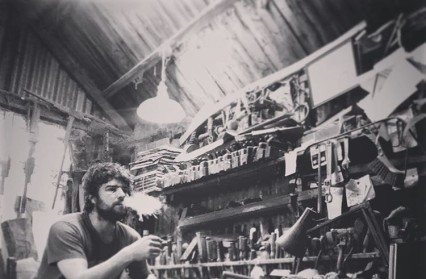Nearly a century has passed since the occasion of one of the National Eisteddfods’ most notorious moments, at Birkenhead 1917. It has since become known as the Eisteddfod of the ‘Black Chair’. It was there that it was revealed the winner, Elis Humphries Evans (better known by his bardic name Hedd Wyn), had been killed at Passchendaele. It became clear when, at the chairing of the bard, the ceremony where the winning poet must stand up and make him or herself known, and no one stood up to claim the award. The chair was draped in a black sheet.
The Black Chair is now a national treasure, as is his home Yr Ysgwrn, Trawsfynydd. After a period of uncertainty regarding the home’s future, Snowdonia National Park announced in 2012 that it would be safeguarded. They have since been working hard on its restoration, its contents now securely stored at Carmarthen, whilst the chair is currently undergoing repairs – parts have become extremely fragile – Yr Ysgwrn is also undergoing maintenance ready for the reopening next year.
Hedd Wyn has since become something of a symbol for all Welsh soldiers lost at war, and will be commemorated at the National Eisteddfod 2017 at Ynys Mon. It was announced on Saint David’s Day this year that Snowdonia National Park’s chosen designer and maker of the chair for 2017 would be Rhodri Owen of Ysbytu Ifan.
Sara Rhoslyn Moore talks to Rhodri about his craft and the symbolism of the chair.
Sara: Can you tell me about your self and your background as a carpenter?
Rhodri: I started woodworking around four years ago as I had all the tools and a workshop after my father. I worked in an art gallery for years after studying fine art at uni. I was arranging exhibitions and framing other people’s work and saw that I wasn’t creating much work myself. I never took an interest in woodworking until I had some kind of quarter life crisis and decided to give it a go. I was lucky enough to get hand tool lessons from Paul Seller who is a master craftsman and a renowned woodworking teacher, the best teacher of anything I’ve ever encountered, and it sort of developed from there. Starting out on my own I was making pretty straight-forward tables and other furniture to order. Then I started making my own designs using timber from old oak beams which opened up a world of ideas. I’ve had more of an art background really and it’s something I’d like to incorporate more into my work so the chair commission is a perfect way of moving in that direction.
Tell us about the bardic chair; what is it?
Presenting a chair to a ‘prifardd’ is an ancient tradition. In the days of Hywel dda, the chair was presented to the head poet of the king’s court. Today it is the main prize at the National Eisteddfod and a centerpiece for the week long festival.
What made you apply to be the maker of The National Eisteddfods bardic chair of Ynys Mon 2017?
They actually asked me so it was a bit of a shock and obviously I said yes but it was something that was always in the back of my mind, almost like a self-deprecating joke, I never thought it would actually happen. I didn’t know how someone would end up in that situation.
When and how did you learn that you had been chosen by Snowdonia National Park, and what was your reaction?
I got a letter from the Park sometime around April 2015 asking if I’d like to discuss the possibility of me making the chair. I was having a bad week as I remember, had no time for anyone or anything and then this came along and blew my mind.
What does it mean to you?
It was strange. I took a while to process the information and though I considered it I couldn’t really say no, and it means a lot to me as an artist firstly because it means someone appreciates your work enough to ask you and secondly because it means I can test myself and push creative boundaries of what I get to do from day to day. Other than that it’s obviously an honour to create the chair for the Eisteddfod, both for its iconic place in Welsh culture and for the fact that it’s an event so deeply ingrained in the Welsh psyche on so many levels – from the actual poetry and competitions to the gigs and art and my own experiences at the event.
Also, on a personal level, my father, who was a lifelong accomplished old-school carpenter made the chair for the 1989 Llanrwst Eisteddfod, which at the time I remember it being a big deal. I was eight years old and remember Nerys, a local woman and a friend of my dad’s, coming around the workshop with a camcorder recording and interviewing him as he worked. Come to think of it that was some forward thinking on her part in rural Nant Conwy in 1989. So yeah, it means a lot.
Is there a theme/brief that you must follow?
Snowdonia National Park have come up with an excellent brief which takes into account a number of factors and it’s trying to tie them all into one coherent idea that’s interesting to me. I’ve enjoyed sketching and throwing ideas around and I actually locked myself in the house for a week going stir crazy turning sketches into more polished versions so at the moment I have four ideas which I’m happy with and then the National Park get to pick and we go from there. I’m not sure if I’m allowed to tell you what the brief is but it revolves around the idea of as we’re looking back and remembering the first world war centenary that it’s important to look forward and step into a brighter, more peaceful future, amongst other things.
Could you give us a hint as to what to expect, will it be as detailed as Eugene Van Fleteren, the Belgium refugee who designed and crafted the original ‘black chair’, or will you be going for a minimal modern style?
2017 will be a hundred years since the ‘black chair’ so it’s something that can’t be ignored in my design process. It’s going to be inevitable that this chair will be compared to the 1917 chair which is obviously held in such high esteem in Wales. I’m not going to redo the exact same thing as Van Fleteren but I’ve a few ideas of how to reference it without going overboard. Y Gadair Ddu has so many things going on within the carvings all over it including on the back of the chair, it’s pretty amazing really. It has a lot (and I mean a lot) of Celtic concepts if you look close enough. Life and death and rebirth and so on so that’s something that can be used and reinterpreted. It’s just finding a way of bringing it all together in an original, contemporary, visually striking and pleasing way. The other thing I have to consider is that (hopefully) some lucky poet, will have to live with this thing in their living room! So I have to restrain and tone down some ideas, though I’d be keen to develop them further for an exhibition in more of a gallery setting.
What wood will you be using and why?
I’m on the lookout for dry local timber with some character, I’m open to which species at the moment but I’ll know when I see it. Having said that there’s some aspects of the ideas I’ve already had that are going to call for specific timber traits but I can’t go into too much information because I might change my mind and I don’t want to give too much information at this stage. Oak is the obvious one as I enjoy working it, same goes for ash but this might call for something different.
When will you start or have you already started?
I’m still at the design stage, and I’ll start the actual work sometime after this summer. I will still need to work on orders and day to day stuff in the meantime so I’m allowing myself plenty of time.
Can you tell us about the process, how do you created a chair for the National Eisteddfod?
Having a strong concept to begin with is key, without that then it’s just another chair. The actual making won’t be much different in technique to anything else I’d work on, though will be incorporating a few new tricks. I’ll be using the months leading to the actual creating of the chair to hone my skills and make a very precise plan of how every piece of the whole should be prepared and worked. Apart from the donkey work of milling the timber to size it’s going to be entirely hand made and I intend to take my time over it. There’s a lot of preparation with something like this, and that’s probably the most important part. Not only getting the concepts and plans ready but getting myself ready, both mentally and physically. I know that sounds like tosh, like I’m preparing for going into orbit or something, but it’s going to be challenging and I want to be able to look at the finished chair at the end and know that it’s exactly as I designed it.
Is it possible to follow your progress on the internet?
My blog is over on calongron.com/blog/ where I’ve sort of been hinting at this commission for a while and I’ll be talking about the making of the chair as we go along as well as other ideas. If it’s easier search for the Rhodri Owen – designer maker page on facebook. Twitter is @calon_gron and instagram is @owsrhod.. and anyone’s more than welcome to contact me however they like, about anything they want.
Will there be a unveiling ceremony for your chair?
I have no idea. I’m going to guess yes, and you’re all invited.












